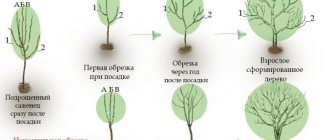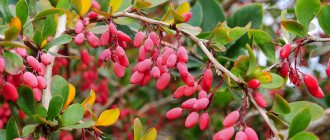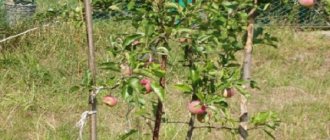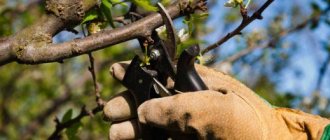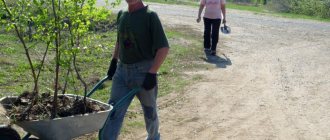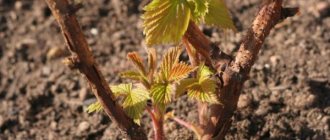Why prune cherry trees in the fall?
In autumn, pruning is carried out for the purpose of thinning and sanitation. The following are subject to removal:
- sick, old, dry branches;
- vegetation at the base of the trunk;
- shoots that grow inside the crown;
- dense, intertwined shoots.
Along with the affected branches and debris, bacteria, insects, and fungal spores are removed from the leaves. This eliminates the possibility of overwintering for pests.
After sanitizing treatment, the tree and trunk circle are sprayed with a 5% urea solution. This fertilizer destroys pests, fungal and infectious pathogens.
Overgrown trees are thinned out to form a proper crown and allow unhindered penetration of sunlight and air.
In autumn, the cherry tree is dormant, so pruning is easier. In spring, active sap flow begins and buds bloom. Any interference with this process can cause gum formation.
Favorable time for pruning
Each region has its own deadlines for the procedure:
- in central Russia, the Volga region, Moscow, Leningrad regions - this is September-mid-October;
- for the Urals and Siberia - no later than the end of September;
- in the south of the country pruning is carried out in November.
Cherry trees can be pruned along with their leaves only in warm regions. In other areas, the procedure is carried out before the leaves are dropped.
The main condition is not to wait for severe frosts, otherwise the winter hardiness of the plant will decrease. Branches are pruned in dry weather, before the onset of cold weather.
Recommendations for choosing deadlines
When pruning cherries, make sure that the pruning shears are sharp.
The timing of pruning depends on the climatic conditions of a particular region. The main indicator is the falling of leaves, which indicates that sap flow in the plant has ended, and cutting off the branches will not harm it. But it’s important to get there before frost sets in. If the cutting sites do not have time to heal before winter, the tree will suffer. Recommended timing by region:
- South - from the beginning to the last ten days of November; Middle zone and Moscow region - from the last ten days of September to mid-October;
- Leningrad region - from early to mid-September;
- Siberia and the Urals - from mid to late September.
It is better to time the procedure to coincide with favorable days according to the lunar calendar 2021:
- September: 1, 6, 7, 15, 16, 26, 27, 28;
- October: 2, 3, 4, 5, 8, 12, 13, 25, 29, 30, 31;
- November: 4, 5, 9, 10, 25, 26, 27, 28.
Inventory
Gardening tools must be of high quality and safe to use. To carry out tree pruning work, use:
- pruner, for removing branches with a diameter of up to 3 cm and young shoots;
- lopper, for working in hard-to-reach places and at the top of trees;
- a hacksaw or garden saw, for cutting branches more than 5 cm;
- stepladder for working on tall varieties of cherry.
Garden supplies must be kept clean after work, this will reduce the likelihood of transmitting the disease from an infected tree to a healthy one. Another important condition is that the tools must be sharp in order to cut the branches accurately and without jagged edges.
Working with gardening gloves will protect your hands from damage. It is advisable to use latex, canvas or leather gloves.
Basic stages
Residents of the Moscow region and mid-latitudes of the Russian Federation begin autumn pruning of cherries from the moment the leaves fall until the end of September. During this work, all weak and damaged branches are removed, since a thoroughly cleaned tree is characterized by higher resistance to winter cold.
Also in the fall, intensive crown thinning is carried out, which consists of removing all branches growing at the wrong angle. Another autumn procedure can monitor the goal of shortening too long bends by a third of their length. To successfully prune cherries in the fall, you should use special gardening tools. It consists of:
- Garden saw with sharp sharpening.
- Secateurs.
- Garden var.
If for some reason the tree begins to stretch upward (this can be caused by overgrowing of the crown and lack of lighting), which complicates the harvesting process, the gardener can use a special type of pruning. It consists in forming a bowl-shaped crown and reducing the height of the tree.
By removing the top branches, you can reduce the height of the tree, as well as increase its width. As soon as the formed wounds heal, the crop will begin intensive growth and increase in green mass. Soon flower buds and fruits will begin to appear on the new branches. And where there were recently cuts, only minor bends will soon remain.
Next, the agronomist will need to promptly get rid of shoots directed inward, preventing the crown from re-thickening. Otherwise, the efforts spent may be useless.
How to trim correctly?
The shape, age, and type of tree influence the methods and purposes of pruning in the autumn, but there are universal rules common to all types:
- The first tier of branches should not deviate from the trunk by more than 40 degrees so that the tree does not break.
- Old and thick shoots are removed using the ring cut method. At the base of the branch, ring-shaped nodules are visible, which are trimmed along the upper edge carefully, without leaving stumps or injuries. You cannot make a cut together with the ring, this will lead to cracking of the wood, suppuration of the bark, and the appearance of a hollow.
- Pruning “to the bud” is carried out to form the correct crown. To thicken the tree, the tree is pruned at the inner bud, and for thinning, at the outer bud. The cut is made at an angle, 5 mm away from the bud.
- Dry and diseased parts of the tree are burned after removal. Disposal will save the cherry from re-infestation by pests.
How to properly prune cherries in the fall, see the video below:
Subtleties of the work
Formative pruning consists of regularly removing excess and old branches from the moment the seedling is placed in open ground. This work is carried out during the first four years of the crop’s life, paying attention to the formation of a strong trunk, crown and skeleton of the future tree.
In order for the new plant to quickly restore its vitality, the frequency of pruning should not be too high. In this regard, some agronomists give preference to spring formative pruning, but sanitary thinning is carried out only in the autumn.
As for trees that have reached five years of age, they can be pruned at any time of the year. When choosing an appropriate time frame, you should be guided by the task being monitored and the expected result.
Modern gardeners practice the following types of pruning::
- Formative. The procedure can only be performed in the spring before sap flows in the branches. This pruning is required for new seedlings.
- Sanitary. Designed to prevent the development of dangerous diseases. It is performed in the fall to protect the tree from pathogenic microorganisms. When carrying out the procedure, it is necessary to completely get rid of branches affected by pathogenic microorganisms, which can take away useful vitality and infect healthy shoots.
- Rejuvenating. This event is carried out either in the autumn or at the beginning of winter. Old and useless trees that have stopped producing crops are pruned. Anti-aging pruning combines the functions of formative and sanitary cleaning.
Trimming by age
The goals and methods of pruning differ for young, old, and fruit-bearing trees. Let's consider the features of the procedure depending on age.
Young
The young tree is just gaining strength, so adhere to the following recommendations:
- In the first autumn, seedlings are not pruned. They can die from frost.
- In young trees, excess shoots are removed to develop a proper crown. Leave strong branches (4-5) at a distance of 10 cm from each other, growing in different directions.
- Grown trees are shortened from above, and excess branches directed into the crown are removed.
- Skeletal and main branches of young plants are not pruned.
The fruiting throughout the life of the tree will depend on how the young cherry tree was pruned.
Old
In order to rejuvenate and increase productivity, excess branches of mature cherries are removed. The shoots are shortened by 1/3 of the total length, thinned out, and the skeletal processes are cut off to the level of developed lateral branches. Do not touch annual shoots.
In autumn, the tree is cleared of dry, diseased, overgrown branches.
Fruit bearing
During the time of active fruiting, annual shoots weaken and skeletal branches become bare. In order to have more berries, a third of the main branches of the tree are cut off by a meter. Developed annual shoots are cut minimally.
In the fall, branches of the crowns of fruit-bearing trees are cut off, which interfere with each other due to growth in the wrong directions.
Mature cherries are pruned every 2-3 years. Young trees are pruned annually until the correct crown is formed.
Importance of the procedure
Starting to understand the basic intricacies of autumn pruning of cherries, it is necessary to understand for what purposes such work is intended and why it is better to carry it out in the fall rather than in the spring. Many novice gardeners do not pay special attention to pruning activities, which negatively affects fruiting and crop growth productivity. In addition, without regular pruning, the cherry tree becomes overgrown, becomes dense and vulnerable to numerous diseases.
Every beginner should understand that a tree can bear fruit until its crown completely thickens. If this happens, you can’t even dream of a good harvest.
This kind of trouble can be explained very simply: the thickened crown does not allow light to pass through, and the branches begin to feel the lack of valuable light. And while young trees can cope with this phenomenon, older trees are susceptible to the death of fruit branches. Constant shadow reduces the number of flower buds and, accordingly, reduces the overall cherry yield. On such crops, ovaries are formed less and less often, and the quality of the fruit becomes extremely low. In addition, all kinds of diseases begin to develop in the thickened crown and insect pests appear.
The task and importance of regular pruning work is as follows::
- Increasing the yield of fruit crops.
- Significant improvement in the quality of berries, their taste and juiciness.
- Developing a good immune system that can resist many dangerous infections and diseases.
- Increased resistance to negative temperatures in winter.
- Extending the life of a culture.
Based on the fact that the pruning scheme directly depends on the task being monitored, before starting work, you need to decide why it is being performed.
Pruning depending on the shape of the tree
There are two types of cherry trees: tree-like and bush-like. The formation of the crown and the location of the fruits occur in different ways, so care has its own nuances.
In bush varieties, flower buds are located only on annual growths, and in tree varieties - on growths of previous years, bouquet branches, and annual shoots.
bush cherry
Bush cherry varieties grow in summer. In autumn, the crown is carefully thinned out. Overgrowth shoots, dry and damaged branches are also removed. To ensure that the plant does not lose strength and productivity, the following conditions are observed:
- young shoots are not cut off (the branch may dry out);
- crown branches are directed outward;
- bushes up to 50 cm long are left untouched;
- the bare ends of the branches are cut off by 30-50 percent of the total length;
If the growth of bush cherries is less than 20 cm per year, intensive cleaning is carried out.
tree cherry
The height of such a tree can reach 5 meters due to strong skeletal-forming branches; therefore, in addition to thinning, it is shortened at a young age.
Unlike bush cherries, annual shoots of tree cherries are pruned. This stimulates the development of lateral branches. Gardeners prefer a combined or sparsely layered system when caring for tree varieties.
Tracked task
In most cases, gardeners begin to learn how to properly prune cherries in the fall in order to get rid of a thickened crown and improve the passage of light to the fruiting branches. This is also necessary to increase the decorativeness of the crop by shaping its appearance. A properly pruned tree is not afraid of external influences, such as strong wind or precipitation.
Pruning work prevents the crown from quickly overgrowing, which is an important factor for comfortable fruit harvesting. In addition, a thickened plant cannot boast of abundant fruiting, since a significant part of the nutrients and minerals goes not to the fruiting branches, but to empty and old branches.
Experts advise pruning to increase productivity. After all, such an event will allow directing the main forces to the formation of lateral branches, where a significant part of the berries is present. In general, there are a lot of reasons and reasons to start pruning cherries in the fall. All that remains is to figure out the main working issues, prepare the equipment and begin the procedure.
Do felt cherry branches need to be pruned?
One of the differences between felt cherries and other varieties is the absence of thickening shoots, which simplifies the pruning procedure, but does not eliminate it.
The crown of the felt cherry is thinned out annually, leaving no more than 10-12 bush shoots. Do not touch annual branches, as berries form on them. The exception is half-meter branches; they are cut by 1/3.
How a gardener prunes felt cherries is shown in the following video:
Compliance with pruning conditions helps to increase the life expectancy of felt cherries.
How to take care of cherries after pruning?
The cut areas are treated with garden varnish, paste or putty. They do this in order to:
- prevent the entry of bacteria and insects;
- the trees did not lose much fluid (moisture comes out of the wound in the first hours).
To activate the protective forces of the tree, after pruning, the Novosil biostimulator is sometimes used (per 10 liters of water 3 ml of the drug).
Before covering the cuts, carefully cut off any irregularities. The composition is applied to a dry surface with a wooden spatula or spatula.
Notes, tips and advice
For those who are just starting to prune cherry trees, it will be useful to listen to the recommendations of experienced gardeners:
- Before forming the crown, the top of the trunk is cut down to the optimal height and only after that the crown is cleared of excess shoots.
- If you have doubts about which branches to trim, look at the buds. Branches with fewer buds are cut off.
- An excess of unnecessary branches from one tree is removed over several seasons.
- Young cherries are not heavily pruned, otherwise there will be fewer fruits.
- The branches of a two-year tree that have grown more than 60 cm are shortened by a third.
- Horizontal branches produce a good harvest of berries. It is necessary to ensure that they grow upward.
- The shoots of the first tier, growing downwards, are cut off.
- To increase productivity, tree growth is limited to 3 m. At the same time, care is taken to ensure that the central stem is 20 cm higher than the upper branches.
Some gardeners rely on the lunar calendar before pruning. The days when the moon is waning and before the new moon are considered favorable.
It is useful for beginner gardeners to study the structure of a cherry tree, learn to distinguish between growths, vegetative and bouquet branches. Pruning done correctly helps cherry trees withstand winter cold more easily and increases life expectancy.
0
0
Copy link
Some tips
In the absence of experience, many gardeners make mistakes when cutting cherry trees in the fall. But this event must be carried out in order to constantly obtain a large harvest. In addition, pruning trees in the fall contributes to the successful wintering of the plant.
When answering the question of how to prune cherries in the fall to ensure a good harvest, experienced gardeners recommend following the following tips for beginners:
- Properly prune cherries before frost.
- Unlike other fruit plants, the buds on a cherry tree are located at the ends of the branches, and not along the entire length. Therefore, during shearing, they are completely removed or simply thinned out, leaving 2-3 pieces on each shoot. This method maintains high yields.
- Complete rejuvenation of cherries can be conveniently done with a saw.
- The tree is trimmed, trying to give all annual branches a length of 30 cm. With this method there will be no bare branches.
- Root growth is removed annually, as it significantly reduces yield.
- For tree cherry, the optimal height is 3 m. Therefore, as soon as the tree reaches this point, the top is trimmed.
- The crown of this crop quickly overgrows. Therefore, pruning work is carried out annually. Otherwise, the growth of fruiting shoots stops.
- They don’t remove all the branches on the cherry tree. Be sure to leave annual shoots and bouquet branches.
Until now, experts have differing opinions on when it is better to prune cherries in spring or autumn. But long-term observations have shown that cutting the plant in autumn brings much more benefit. It also helps to better survive the winter cold. The goal of autumn cultivation is not to completely change the appearance of a tree or bush, but to correct the shape of the crown and sanitary cleansing. It is necessary to improve productivity and prevent various diseases.
